Welcome to the latest selection of recent top articles in the physica status solidi journals. Get a glimpse of our publication spectrum and visit our pages by clicking on any of the DOI links below.
Microscopic analysis of performance variations in carbon nanotube field emission cathodes
S. Berhanu, O. Gröning, Z. Chen, J. Merikhi, M. Kaiser, N. L. Rupesinghe, and P. K. Bachmann
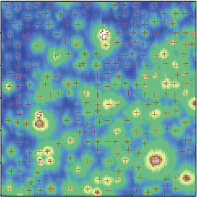 Despite intensive research and development efforts, the fabrication of reliable carbon nanotube (CNT) cathodes for high current density applications remains a formidable challenge. This study gives a detailed insight into the functioning and properties of CNT-based electron emitters. It allows for the identification of crucial parameters – the maximum current that can be drawn from individual emitters and the contact resistance – controlling the sample macroscopic performances. Scanning anode field emission microscopy (SAFEM) characterization was carried out on CNT-based electron emitter arrays grown using different methods – thermal CVD and microwave plasma CVD – and fabrication processes. Different degradation characteristics were observed by SEM after SAFEM characterization.
Despite intensive research and development efforts, the fabrication of reliable carbon nanotube (CNT) cathodes for high current density applications remains a formidable challenge. This study gives a detailed insight into the functioning and properties of CNT-based electron emitters. It allows for the identification of crucial parameters – the maximum current that can be drawn from individual emitters and the contact resistance – controlling the sample macroscopic performances. Scanning anode field emission microscopy (SAFEM) characterization was carried out on CNT-based electron emitter arrays grown using different methods – thermal CVD and microwave plasma CVD – and fabrication processes. Different degradation characteristics were observed by SEM after SAFEM characterization.
Editor’s Choice
Phys. Status Solidi A (2012) DOI 10.1002/pssa.201228296
Phase switching at low field and large sustainable strain output in domain engineered ferroic crystals
P. Finkel, A. Amin, S. Lofland, J. Yao, and D. Viehland
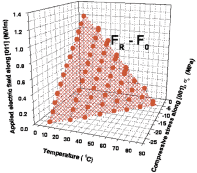 Finkel et al. show that the ferroic morphotropic relaxor PIN–PMN–PT (i.e., ternary lead indium niobate – lead magnesium niobate – lead titanate) crystal exhibited unusual lack of fatigue after one million (0.5%) strain cycles, compared to other ferroic systems degrading after a few cycles. A strain accommodation model is proposed as a plausible explanation to sustainable phase switching, supported by polarized light microscopy experiments under applied electric field. X-ray diffraction experiments on “free” and “clamped” crystals reveal a lattice strain that is in very good agreement with the macroscopic observation and phenomenological model calculation. The results confirm the proposed hypothesis of a phase transition from macro-domain ferroelectric rhombohedral to mono-domain ferroelectric orthorhombic. A stress-field/temperature phase diagram for it has been established.
Finkel et al. show that the ferroic morphotropic relaxor PIN–PMN–PT (i.e., ternary lead indium niobate – lead magnesium niobate – lead titanate) crystal exhibited unusual lack of fatigue after one million (0.5%) strain cycles, compared to other ferroic systems degrading after a few cycles. A strain accommodation model is proposed as a plausible explanation to sustainable phase switching, supported by polarized light microscopy experiments under applied electric field. X-ray diffraction experiments on “free” and “clamped” crystals reveal a lattice strain that is in very good agreement with the macroscopic observation and phenomenological model calculation. The results confirm the proposed hypothesis of a phase transition from macro-domain ferroelectric rhombohedral to mono-domain ferroelectric orthorhombic. A stress-field/temperature phase diagram for it has been established.
Advanced Materials Physics
Phys. Status Solidi A (2012) DOI 10.1002/pssa.201228314
Non-periodic nanoscale templates by diffraction mask projection laser ablation
Marisa Mäder, Thomas Höche, and Bernd Rauschenbach
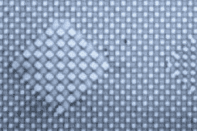 A route towards a top–down fabrication of non-periodically arranged substrate-bound metal nanostructure arrays using mask projection laser ablation is presented. In the first step phase masks featuring non-periodic patterns are fabricated by laser lithography and subsequent ion-beam etching. It is shown that the geometry of the diffraction mask projection laser ablation (DiMPLA) setup plays a crucial role for the ability to transfer non-periodic phase mask structures into arrangement of nanodots. These dots are exemplarily used as templates for the growth of sculptured thin films by glancing-angle deposition.
A route towards a top–down fabrication of non-periodically arranged substrate-bound metal nanostructure arrays using mask projection laser ablation is presented. In the first step phase masks featuring non-periodic patterns are fabricated by laser lithography and subsequent ion-beam etching. It is shown that the geometry of the diffraction mask projection laser ablation (DiMPLA) setup plays a crucial role for the ability to transfer non-periodic phase mask structures into arrangement of nanodots. These dots are exemplarily used as templates for the growth of sculptured thin films by glancing-angle deposition.
Phys. Status Solidi A (2012) DOI 10.1002/pssa.201228363
Amorphous structures of Ge/Sb/Te alloys: Density functional simulations
J. Akola and R. O. Jones
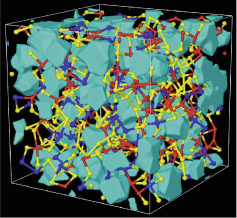 Since their first development in the 1960’s, phase-change memory (PCM) materials have become essential components of optical memories (DVD-RW, Blu-ray Disc etc.). They are now poised to play a decisive role in future non-volatile computer memories. PCM materials are restricted to those with an extremely rapid and reversible transition between the amorphous and crystalline phases of an appropriate recording medium, and their development and optimization has been hindered by the inherent difficulties in determining amorphous structures. Alloys of germanium, antimony, and tellurium (“GST” alloys) are among the most widely used in the above contexts, and there has been much speculation concerning their amorphous structures. Theoreticians were slow to appreciate the rich array of problems awaiting their attention, but the past few years have seen a dramatic change in this situation. Density functional calculations, which are generally free of adjustable parameters, have now been reported on numerous systems. Akola and Jones review the information that has resulted about the amorphous structures of GST-alloys.
Since their first development in the 1960’s, phase-change memory (PCM) materials have become essential components of optical memories (DVD-RW, Blu-ray Disc etc.). They are now poised to play a decisive role in future non-volatile computer memories. PCM materials are restricted to those with an extremely rapid and reversible transition between the amorphous and crystalline phases of an appropriate recording medium, and their development and optimization has been hindered by the inherent difficulties in determining amorphous structures. Alloys of germanium, antimony, and tellurium (“GST” alloys) are among the most widely used in the above contexts, and there has been much speculation concerning their amorphous structures. Theoreticians were slow to appreciate the rich array of problems awaiting their attention, but the past few years have seen a dramatic change in this situation. Density functional calculations, which are generally free of adjustable parameters, have now been reported on numerous systems. Akola and Jones review the information that has resulted about the amorphous structures of GST-alloys.
Feature Article
Phys. Status Solidi B (2012) DOI 10.1002/pssb.201200393
Phase-change processors, memristors and memflectors
C. David Wright, Lei Wang, Mustafa M. Aziz, Jorge A. Vazquez Diosdado, and Peter Ashwin
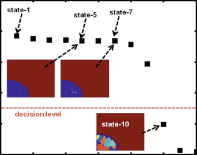 Phase-change materials can be crystallized in picoseconds and amorphized in femtoseconds, but remain stable against spontaneous crystallization for many years. They exhibit huge differences in optical and electrical properties between the amorphous and crystalline phases. Such properties have led, over the last four decades, to the successful development of both optical and binary non-volatile phase-change memories. However, such binary memories only ‘scratch the surface’ in terms of the remarkable potential applications of phase-change materials and devices, which extend to arithemetic, logical and bio-insprired (or neuromorphic) processing. Wright et al. introduce and explain some of this remarkable functionality inherent to phase-change systems.
Phase-change materials can be crystallized in picoseconds and amorphized in femtoseconds, but remain stable against spontaneous crystallization for many years. They exhibit huge differences in optical and electrical properties between the amorphous and crystalline phases. Such properties have led, over the last four decades, to the successful development of both optical and binary non-volatile phase-change memories. However, such binary memories only ‘scratch the surface’ in terms of the remarkable potential applications of phase-change materials and devices, which extend to arithemetic, logical and bio-insprired (or neuromorphic) processing. Wright et al. introduce and explain some of this remarkable functionality inherent to phase-change systems.
Phys. Status Solidi B (2012) DOI 10.1002/pssb.201200378
Transition voltage spectroscopy in vacuum break junction: The standard tunneling barrier model and beyond
Ioan Bâldea and Horst Köppel
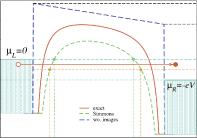 Recent experiments on transition voltage spectroscopy (TVS) in mechanically controllable vacuum break juncti
Recent experiments on transition voltage spectroscopy (TVS) in mechanically controllable vacuum break juncti
ons have been interpreted theoretically by using a Simmons WKB-type approach of the transport by tunneling based on the standard vacuum barrier picture. Bâldea and Köppel present an analysis demonstrating the inconsistencies of that approach. Detailed results obtained by exactly solving the Schrödinger equation show that the standard tunneling barrier model fails to describe the experimental vacuum TVS data, indicating that the physical description within that model is incomplete. The authors demonstrate that the inclusion of electron states at the electrodes’ surface significantly improves the agreement with experiment.
Phys. Status Solidi B (2012) DOI 10.1002/pssb.201248034

















